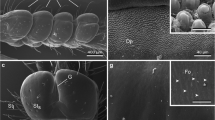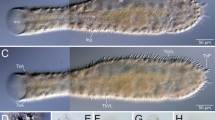Summary
The ultrastructure of anteroventral gland cells with processes penetrating the epidermis inPterastericola bergensis, P. fedotovi, P. pellucida and the undescribedP. (sp. Rottnest) was studied with transmission and scanning electron microscopy. Specimens ofP. pellucida were shock frozen in situ in the epithelium of their asteroid host to study the function of the glands. Secretory products released from the gland cell processes fan out towards the host epithelium. The glands are concluded to have an adhesive function. They are compared with similar structures in Neodermata and other rhabdocoel taxa. The phylogenetic significance of the glands is discussed.
Similar content being viewed by others
Abbreviations
- b :
-
basal lamina
- c :
-
cilium
- cr :
-
ciliary rootlets
- d :
-
septate desmosome
- g :
-
gland cell process
- gc :
-
gland cell
- h :
-
host epithelium
- m :
-
mitochondria
- mc :
-
muscle cell
- mv :
-
microvilli
- mt :
-
microtubules
- n :
-
nucleus
- o :
-
ootype
- pm :
-
plasma membrane
- s :
-
secretory granule
- sm :
-
secretory material released from dissolving secretory granules
References
Bresciani J, Køie M (1970) On the ultrastructure of the epidermis of the adult female ofKronborgia amphipodicola Christensen & Kanneworff, 1964 (Turbellaria, Neorhabdocoela). Ophelia 8:209–230
Cannon LRG (1986) The Pterastericolidae:parasitic turbellarians from starfish. In: Cremin M, Dobson C, Moorehouse DE (eds) Parasite Lives. University of Queensland Press, St. Lucia London New York, pp 15–32
Ehlers U (1985) Das Phylogenetische System der Plathelminthes. Gustav Fischer, Stuttgart New York, 317 pp
El-Naggar MM, Kearn GC (1980) Ultrastructural observations on the anterior adhesive apparatus in the MonogeneansDactylogyrus amphibothrium Wagener, 1857 andD. hemiamphibothrium Ergens, 1956. Z. Parasitenkd. 61:223–241
El-Naggar MM, Kearn GC (1983a) Glands associated with the anterior adhesive areas and body margins in the skin-parasitic monogeneanEntobdella soleae. Int J Parasitol 13:67–81
El-Naggar MM, Kearn GC (1983b) The tegument of the monogenean gill parasitesDactylogyrus amphibothrium andD. hemiamphibothrium. Int J Parasitol 13:579–592
El-Naggar MM, Kearn GC (1989) Haptor glands in the gill-parasitic ancyrocephaline monogeneanCichlidogyrus hallitypicus and the report of a possible prokaryotic symbiont. Int J Parasitol 19:401–408
Joffe BI (1987) On the evolution of the pharynx in the Platyhelminthes. In:Mamkaev YV (ed) Morphology of Turbellarians Pogonophores ans Ascidians (in Russian), vol 167. USSR Academy of Sciences, Proceedings of the Zoological Institute, Leningrand, pp 34–71
Jondelius U (1988) Epidermal ultrastructure of adults and juveniles ofTriloborhynchus astropectinis (Dalyellioida, Platyhelminthes). Fortschr Zool 36:39–44
Jondelius U (1989)Pterastericola pellucida n. sp., an endosymbiotic flatworm (Dalyellioida:Pterastericolidae) fromAstropecten irregularis, with notes on the monophyly of the genusPterastericola. Ophelia 30:55–62
Jondelius U (1992a) NewPterastericola species and a cladistic analysis of the Pterastericolidae. Zool Scr 21 (in press)
Jondelius U (1992b) Sperm morphology of the Pterastericolidae (Platyhelminthes, Rhabdocoela), phylogenetic implications. Zool Scr (in press)
Jondelius U (in press) A new species ofPterastericola (Platyhelminthes, Dalyellioida) fromAstropecten polyachanthus, with observations on the epidermis and gland cells. In: Morton B (ed) Proceedings of the fourth international marine biological workshop: the marine flora and fauna of Hong Kong and southern China, Hong Kong 1989
Køie M, Bresciani J (1973) On the ultrastructure of the larva ofKronborgia amphipodicola Christensen and Kanneworff, 1964 (Turbellaria, Neorhabdocoela). Ophelia 12:171–203
MacKinnon B, Burt MDB, Pike A (1981) Ultrastructure of the epidermis of adult and embryonicParvortex species (Turbellaria, Eulecithophora). Hydrobiologia 84:241–252
Noury-Sraïri N, Justine J, Euzet L (1989) Ultrastructure du tégument de trois especès deParavortex (Rhabdocoela, “Dalyellioida”, Graffillidae), Turbellariés parasites intestinaux de Mollusques. Ann Sci Nat Zool 10:155–170
Rohde K (1986) Ultrastructural studies ofAustramphilina elongata Johnston, 1931 (Cestoda, Amphilinidea). Zoomorphology 106:91–102
Tyler S (1976) Comparative ultrastructure of adhesive systems in the Turbellaria. Zoomorphologie 84:1–76
Tyler S (1988) The role of function in determination of homology and convergence-examples from invertebrate adhesive organs. Fortschr Zool 36:331–347
Williams JB (1988) Ultrastructural studies onKronborgia (Platyhelminthes: Fecampiidae):the spermatozoon. Int J Parasitol 18:477–483
Xylander W (1986) Zur Biologie und Ultrastruktur der Gyrocotylida und Amphilinida sowie ihre Stellung im phylogenetischen System der Plathelminthes. Doctoral dissertation, Göttingen 304 pp
Author information
Authors and Affiliations
Rights and permissions
About this article
Cite this article
Jondelius, U. Adhesive glands in the Pterastericolidae (Plathelminthes, Rhabdocoela). Zoomorphology 111, 229–238 (1992). https://doi.org/10.1007/BF01633011
Received:
Issue Date:
DOI: https://doi.org/10.1007/BF01633011




